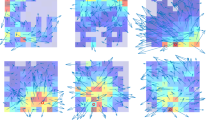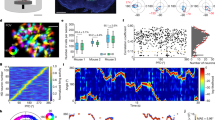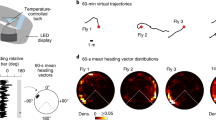Abstract
Head-direction cells have frequently been regarded as an internal 'compass' that can be used for navigation, although there is little evidence showing a link between their activity and spatial behavior. In a navigational task requiring the use of internal cues to return to a home location without vision (path integration), we found a robust correlation between head-direction cell activity and the rat's heading error in the rat's homing behavior. We observed two different correction processes that rats used to improve performance after an error. The more frequent one consists of 'resetting' the cell whenever the rat returns to the home location. However, we found that when large errors occur, the head-direction system has the ability to 'remap' and set a new reference frame, which is then used in subsequent trials. We also offer some insight into how these two correction processes operate when rats make an error.
This is a preview of subscription content, access via your institution
Access options
Subscribe to this journal
Receive 12 print issues and online access
$209.00 per year
only $17.42 per issue
Buy this article
- Purchase on Springer Link
- Instant access to full article PDF
Prices may be subject to local taxes which are calculated during checkout








Similar content being viewed by others
References
Darwin, C. Origin of certain instincts. Nature VII, 417–418 (1873).
Mittelstaedt, M.L. & Mittelstaedt, H. Homing by path integration in a mammal. Naturwissenschaft 67, 566–567 (1980).
Etienne, A.S. & Jeffery, K.J. Path integration in mammals. Hippocampus 14, 180–192 (2004).
O'Keefe, J. & Dostrovsky, J. The hippocampus as a spatial map. Preliminary evidence from unit activity in the freely-moving rat. Brain Res. 34, 171–175 (1971).
Taube, J.S., Muller, R.U. & Ranck, J.B. Head-direction cells recorded from the postsubiculum of freely-moving rats. I. Description and quantitative analysis. J. Neurosci. 10, 420–435 (1990).
Hafting, T., Fyhn, M., Molden, S., Moser, M.B. & Moser, E.I. Microstructure of a spatial map in the entorhinal cortex. Nature 436, 801–806 (2005).
Muir, G.M. & Taube, J.S. The neural correlates of navigation: do head direction and place cells guide spatial behavior? Behav. Cogn. Neurosci. Rev. 1, 297–317 (2002).
Save, E. & Poucet, B. Do place cells guide spatial behaviour? in Hippocampal Place fields, Relevance to learning and memory (ed., Mizumori, S.J.) 138–149 (Oxford University Press, New York, 2008).
Wiener, S.I. & Taube, J.S. (eds.). Head Direction Cells and the Neural Mechanisms of Spatial Orientation (MIT Press, Cambridge, Massachusetts, USA, 2005).
Taube, J.S. The head direction signal: origins and sensory-motor integration. Annu. Rev. Neurosci. 30, 181–207 (2007).
McNaughton, B.L., Chen, L.L. & Markus, E.J. “Dead reckoning”, landmark learning, and the sense of direction: a neurphysiological and computational hypothesis. J. Cogn. Neurosci. 3, 190–202 (1991).
Taube, J.S. Head direction cells and the neurophysiological basis for a sense of direction. Prog. Neurobiol. 55, 225–256 (1998).
van der Meer, M.A., Richmond, Z., Braga, R.M., Wood, E.R. & Dudchenko, P.A. Evidence for the use of an internal sense of direction in homing. Behav. Neurosci. 124, 164–169 (2010).
McNaughton, B.L., Battaglia, F.P., Jensen, O., Moser, E.I. & Moser, M.B. Path integration and the neural basis of the 'cognitive map'. Nat. Rev. Neurosci. 7, 663–678 (2006).
Hasselmo, M.E. Grid cell mechanisms and function: contributions of entorhinal persistent spiking and phase resetting. Hippocampus 18, 1213–1229 (2008).
Gallistel, C.R. The organization of learning (MIT Press, Cambridge, Massachusetts, USA, 1990).
Souman, J.L., Frissen, I., Sreenivasa, M.N. & Ernst, M.O. Walking straight into circles. Curr. Biol. 19, 1538–1542 (2009).
Etienne, A.S., Maurer, R., Boulens, V., Levy, A. & Rowe, T. Resetting the path integrator: a basic condition for route-based navigation. J. Exp. Biol. 207, 1491–1508 (2004).
Knaden, M. & Wehner, R. Ant navigation: resetting the path integrator. J. Exp. Biol. 209, 26–31 (2006).
Taube, J.S. Head direction cells recorded in the anterior thalamic nuclei of freely moving rats. J. Neurosci. 15, 70–86 (1995).
Whishaw, I.Q., Coles, B.L. & Bellerive, C.H. Food carrying: a new method for naturalistic studies of spontaneous and forced alternation. J. Neurosci. Methods 61, 139–143 (1995).
Etienne, A.S., Boulens, V., Maurer, R., Rowe, T. & Siegrist, C. A brief view of known landmarks reorientates path integration in hamsters. Naturwissenschaften 87, 494–498 (2000).
Goodridge, J.P. & Taube, J.S. Preferential use of the landmark navigational system by head direction cells in rats. Behav. Neurosci. 109, 49–61 (1995).
Goodridge, J.P., Dudchenko, P.A., Worboys, K.A., Golob, E.J. & Taube, J.S. Cue control and head direction cells. Behav. Neurosci. 112, 749–761 (1998).
Clark, B.J., Harris, M.J. & Taube, J.S. Control of anterodorsal thalamic head direction cells by environmental boundaries: Comparison with conflicting distal landmarks. Hippocampus 22, 172–187 (2012).
Golob, E.J., Stackman, R.W., Wong, A.C. & Taube, J.S. On the behavioral significance of head direction cells: neural and behavioral dynamics during spatial memory tasks. Behav. Neurosci. 115, 285–304 (2001).
Cheng, K. Whither geometry? Troubles of the geometric module. Trends Cogn. Sci. 12, 355–361 (2008).
Steck, K., Hansson, B.S. & Knaden, M. Desert ants benefit from combining visual and olfactory landmarks. J. Exp. Biol. 214, 1307–1312 (2011).
Collett, T.S. & Graham, P. Animal navigation: path integration, visual landmarks and cognitive maps. Curr. Biol. 14, R475–R477 (2004).
Gothard, K.M., Skaggs, W.E. & McNaughton, B.L. Dynamics of mismatch correction in the hippocampal ensemble code for space: interaction between path integration and environmental cues. J. Neurosci. 16, 8027–8040 (1996).
Gothard, K.M., Skaggs, W.E., Moore, K.M. & McNaughton, B.L. Binding of hippocampal CA1 neural activity to multiple reference frames in a landmark-based navigation task. J. Neurosci. 16, 823–835 (1996).
Derdikman, D. et al. Fragmentation of grid cell maps in a multicompartment environment. Nat. Neurosci. 12, 1325–1332 (2009).
Taube, J.S., Muller, R.U. & Ranck, J.B. Jr. Head-direction cells recorded from the postsubiculum in freely moving rats. II. Effects of environmental manipulations. J. Neurosci. 10, 436–447 (1990).
Muller, R.U. & Kubie, J.L. The effects of changes in the environment on the spatial firing of hippocampal complex-spike cells. J. Neurosci. 7, 1951–1968 (1987).
Markus, E.J. et al. Interactions between location and task affect the spatial and directional firing of hippocampal neurons. J. Neurosci. 15, 7079–7094 (1995).
Leutgeb, S. et al. Independent codes for spatial and episodic memory in hippocampal neuronal ensembles. Science 309, 619–623 (2005).
Knierim, J.J., Kudrimoti, H.S. & McNaughton, B.L. Interactions between idiothetic cues and external landmarks in the control of place cells and head direction cells. J. Neurophysiol. 80, 425–446 (1998).
Knierim, J.J., Kudrimoti, H.S. & McNaughton, B.L. Place cells, head direction cells, and the learning of landmark stability. J. Neurosci. 15, 1648–1659 (1995).
Schultz, W. & Dickinson, A. Neuronal coding of prediction errors. Annu. Rev. Neurosci. 23, 473–500 (2000).
Fiorillo, C.D., Tobler, P.N. & Schultz, W. Discrete coding of reward probability and uncertainty by dopamine neurons. Science 299, 1898–1902 (2003).
Sharp, P.E., Tinkelman, A. & Cho, J. Angular velocity and head direction signals recorded from the dorsal tegmental nucleus of gudden in the rat: implications for path integration in the head direction cell circuit. Behav. Neurosci. 115, 571–588 (2001).
Bassett, J.P. & Taube, J.S. Neural correlates for angular head velocity in the rat dorsal tegmental nucleus. J. Neurosci. 21, 5740–5751 (2001).
Matsumoto, M. & Hikosaka, O. Lateral habenula as a source of negative reward signals in dopamine neurons. Nature 447, 1111–1115 (2007).
Balcita-Pedicino, J.J., Omelchenko, N., Bell, R. & Sesack, S.R. The inhibitory influence of the lateral habenula on midbrain dopamine cells: ultrastructural evidence for indirect mediation via the rostromedial mesopontine tegmental nucleus. J. Comp. Neurol. 519, 1143–1164 (2011).
Ito, S., Stuphorn, V., Brown, J.W. & Schall, J.D. Performance monitoring by the anterior cingulate cortex during saccade countermanding. Science 302, 120–122 (2003).
Michelet, T., Bioulac, B., Guehl, D., Goillandeau, M. & Burbaud, P. Single medial prefrontal neurons cope with error. PLoS ONE 4, e6240 (2009).
Whishaw, I.Q., Maaswinkel, H., Gonzalez, C.L. & Kolb, B. Deficits in allothetic and idiothetic spatial behavior in rats with posterior cingulate cortex lesions. Behav. Brain Res. 118, 67–76 (2001).
Bouret, S. & Sara, S.J. Network reset: a simplified overarching theory of locus coeruleus noradrenaline function. Trends Neurosci. 28, 574–582 (2005).
Frohardt, R.J., Bassett, J.P. & Taube, J.S. Path integration and lesions within the head direction cell circuit: comparison between the roles of the anterodorsal thalamus and dorsal tegmental nucleus. Behav. Neurosci. 120, 135–149 (2006).
Whishaw, I.Q. & Maaswinkel, H. Rats with fimbria-fornix lesions are impaired in path integration: a role for the hippocampus in “sense of direction”. J. Neurosci. 18, 3050–3058 (1998).
Acknowledgements
We thank R. Leaton, P. Trifieff and E. Lesburgueres for their valuable comments on the manuscript. These experiments were supported by US National Institutes of Health grants DC009318 and NS053907.
Author information
Authors and Affiliations
Contributions
S.V. and J.S.T. conceived and designed the study, discussed the findings, and wrote the manuscript. S.V. performed the experiments and analyzed the results.
Corresponding author
Ethics declarations
Competing interests
The authors declare no competing financial interests.
Supplementary information
Supplementary Text and Figures
Supplementary Figures 1–16 (PDF 4436 kb)
Rights and permissions
About this article
Cite this article
Valerio, S., Taube, J. Path integration: how the head direction signal maintains and corrects spatial orientation. Nat Neurosci 15, 1445–1453 (2012). https://doi.org/10.1038/nn.3215
Received:
Accepted:
Published:
Issue Date:
DOI: https://doi.org/10.1038/nn.3215
This article is cited by
-
Population dynamics of head-direction neurons during drift and reorientation
Nature (2023)
-
Learning orientations: a discrete geometry model
Journal of Applied and Computational Topology (2022)
-
Volumetric spatial behaviour in rats reveals the anisotropic organisation of navigation
Animal Cognition (2021)
-
Grid cells are modulated by local head direction
Nature Communications (2020)
-
Behavior-dependent directional tuning in the human visual-navigation network
Nature Communications (2020)



